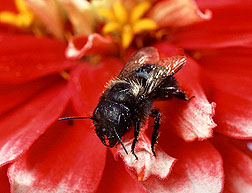This page has been archived and is being provided for reference purposes only. The page is no longer being updated, and therefore, links on the page may be invalid.
|
|
Bees Help Maintain Plant CollectionBy Ben HardinOctober 16, 1997 Maintaining collections of seeds and plants for many generations without altering their genetic variability is not a simple matter of occasionally producing fresh seed supplies. It's a laborious job--for man and bees. At the North Central Regional Plant Introduction Station in Ames, Iowa, a new addition to this vital workforce is the Osmia or mason bee. When the Iowa station was founded in 1948, hand pollination was the norm. Honey bees were put to work in the 1970's, and they remain the station's principal pollinating workhorses. But, over the winter, hives normally don't have enough time to build up their numbers for pollinations that must be done early in the spring. Purchasing additional bees from suppliers in the southern United States is costly and runs the risk of conveying diseases and mites. That's when cool-season workers like Osmia come in handy. Introduced from Japan in 1977, solitary, hard-working Osmia bees have for the past 2 years proved their worth in pollinating canola and other members of the mustard or Brassicaceae family. The bees emerge from artificial nests to pollinate at precisely the time Brassica plants flower. The station also uses bumblebees. Their long tongues and large size allow them to pollinate flowers like snapdragons. Other plants the station maintains include pumpkins, corn, sunflowers, melons, cucumbers, carrots, chicory, herbaceous ornamentals and shrubs. An article on controlled pollination appears in the October Agricultural Research magazine. The article also is on the World Wide Web at: /is/AR/archive/oct97/pollen1097.htm The Ames station holds more than 40,000 genetically separate types of plants from around the world. The facility is part of a national system for maintaining the genetic diversity of crop plants and their relatives as potential sources of disease and pest resistance or as future crops. Scientific contact: Peter K. Bretting, ARS North Central Regional Plant Introduction Station, Ames, Iowa, phone (515) 294-3255, fax (504) 294-1903, nc7pb@ars-grin.gov. |

